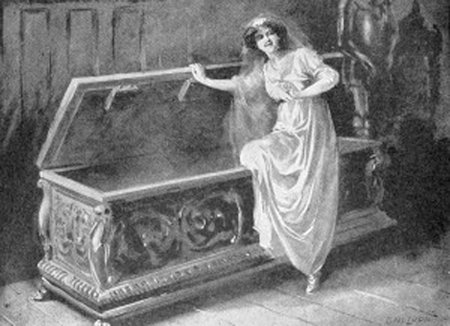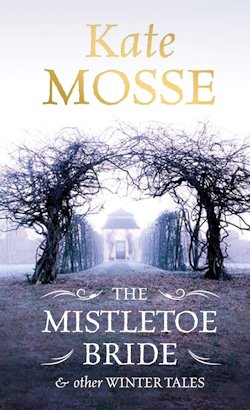Welcome back to the Short Fiction Spotlight, a weekly column dedicated to doing exactly what it says in the header: shining a light on the some of the best and most relevant fiction of the aforementioned form.
This Thursday sees the release of The Mistletoe Bride and Other Haunting Tales in the UK, a collection of chilling short fiction from the co-founder of the formerly Orange Prize for Women’s Fiction: namely bestselling author Kate Mosse.
I’ve been aware of Mosse’s work for ages—it’s hard not to be when her books are sold in supermarkets alongside bread and milk and other essentials—however I hadn’t read anything she’d written till today. Something in my lizard brain had conflated her with Dan Brown—a comparison made in lots of Labyrinth reviews, I see, so it’s not just me—which was reason enough to stay away, I dare say. But I simply can’t resist a good ghost story, and there are fully fourteen of these in The Mistletoe Bride and Other Haunting Tales, two of which we’ll shine the Spotlight on this week, beginning with the titular tale.
“The Mistletoe Bride” chronicles the wedding day of a young woman five hundred or so years ago. The party is held in Bramshill House in the middle of the winter, thus “there is mistletoe and holly, white berries and red,” and—in a tradition as old as time—a fine feast, made finer with wine. When all the sweetmeats are eaten, the new wife of Lord Lovell suggests “a game of hide-and-seek, for all those who yet have strength in their legs.”
The play is a way, attentive readers will realise, of delaying the daunting prospect of the wedding bed, an inevitability which leaves our narrator feeling conflicted. “I can see Lovell’s eyes on me and know he means to be the one who discovers my hiding place. There is part of me that shrinks at the thought of it, but he is a gentle man.”
Nevertheless, when the game begins, the mistletoe bride—Mosse gives her no other name—decides on one hell of a hiding place: in a “wooden coffer [that] is deep and long, the length of a man, and bound fast by four wide metal bands.” She settles into it as if it were a bed, and though she does not mean to sleep, sleep she does… with haunting consequences:
My head fills with strange dreams, wild imaginings that follow one hard on the heels of the next. A kaleidoscope of brightly coloured glass, becoming darker. Like candles on a cake being blown out, one by one by one. My sleep grows deeper. Memories of the springs and summers and autumns of childhood. A winter wedding of tulle and silk, the white of the mistletoe bough and the green of the holly decking the hall.
The food on the marriage table grows cold, congeals. They are looking and calling out my name. It is no longer a game. Impatience turns to fear.
Lovell does not find me.
Her life flashes before her eyes, and in time, the mistletoe bride dies… but that is not the end of her narrative. She can “still see things,” you see, “in the house and beyond its boundaries.” She can “hear things and sense the shifting of the world, even though [she is] no longer part of it.” In this fashion, days pass; days and week and years, even. It will be several centuries before she is finally found, a smiling skeleton accidentally—or not—locked in a box.

As the author asserts in her short survey of the various versions of this tale, which has been told almost as long as there were tales to tell, “The Mistletoe Bride” is “grisly, oddly compelling […] the sort of story that sticks in the imagination,” and indeed it does. Some say it is founded on fact. Others suggest it springs from a song. In any event, it’s been an inspiration to many authors through the ages:
Charles Somerset produced a play of the same name in 1835, Henry James wrote ‘The Romance of Certain Old Clothes’ in 1868, transposed to eighteenth-century Massachusetts but clearly inspired by the story, and Susan E. Wallace published a short story—‘Ginevra or The Old Oak Chest: A Christmas Story’—in 1887. The tragic tale, a favourite of the protagonist, Brandon Shaw, is recounted in Hitchcock’s 1948 film, Rope. Jeanette Winterson wrote a haunting Christmas version of the story in 2002.
Whatever its legacy, “The Mistletoe Bride” is a fitting fiction with which to kick off this collection—and in a sense to bring it to an end as well, because the final short is another take on the same tale, if anything more impressive than the first: a strangely straightforward story for all its suggestiveness.
“The Yellow Scarf,” for its part, takes place in an ancient Oxfordshire estate in the mid-1970s. “Sophia was accompanying her aunt on a coach tour of minor stately homes. A week’s holiday from work, all expenses paid. For the most part, she was enjoying herself […] but Sophia was finding it a little tiring to be always in company,” so when the opportunity arises to explore on her own for a few moments, she hardly hesitates.
Intrigued by the selfsame folklore Mosse explores in the starter story—“of a young bride […] said to have disappeared here on her wedding night”—Sophia ventures into a small family chapel wherein she spots “a piece of historic graffiti” relating to the long-dead newlywed. This is enough of a discovery to make her day, but as she learns when she makes to meet her aunt, the fun has only just begun:
The sky had clouded over while she’d been inside and there was now an unseasonable chill in the air. Everything looked dull and grey. Sophia shivered. As she walked back through the avenue of trees, the world seemed bleached of colour. No sun burnishing the leaves of the beeches that stood at the furthest edges of the lawns, no birdsong. And the path between them seemed longer than before, the twisting branches that had provided a green canopy now oddly bare.
Sophia stopped. She wasn’t sure how it could have happened, but she had somehow lost her bearings. [She] had the distinct impression of being in a different place. Or, rather, the same place which no longer looked quite the same.
Suffice it to say Sophia is transported back in time, as I gather the protagonist of Labyrinth was—what? I may have watched the first fifteen minutes of last year’s TV series—in this instance to the fateful day when the mistletoe bride went missing. But it, too, looks a little different.
Quickly, it becomes clear that this is not the old story Sophia knows. This young woman conceals herself in a panic room of sorts as opposed to an oaken box, and not because of some silly game; soldiers have come to Minster Lovell Hall in the name of the king to seize her husband and his whole household. As Sophia watches, struck dumb by the incredible turn her day has taken, one such angry man arrives in the room wherein the mistletoe bride hides:
Though she could barely breathe from fear, Sophia stood her ground. Whatever had happened five hundred years ago—if she was seeing an echo of things that had been—she was determined it would be different this time. Whatever tragedy had taken place in this room, she would not let the story have the same ending.
But she could only watch with mounting fear, mounting rage, as the soldiers ransacked the room, to teach the traitor Lovell a lesson.
Whereas “The Mistletoe Bride” is an antiquated tale retold relatively well, “The Yellow Scarf” takes the fateful day it details as a basis and weaves an ingenious time-travel narrative into its familiar fibre. I enjoyed the latter markedly more than the former, if I’m honest—the extra dimension Mosse superimposes on the old story allows her to engage with the actions of its characters in a manner beyond the strict limits of the original, hidebound by tradition as it is—but both make for great ghost stories, distinct from one another despite their identical heritage.
Ideal reading, really, for the creepy season.
The Mistletoe Bride and Other Haunting Tales is available October 24th from Orion (UK)
Niall Alexander is an extra-curricular English teacher who reads and writes about all things weird and wonderful for The Speculative Scotsman, Strange Horizons, and Tor.com. He’s been known to tweet, twoo.










